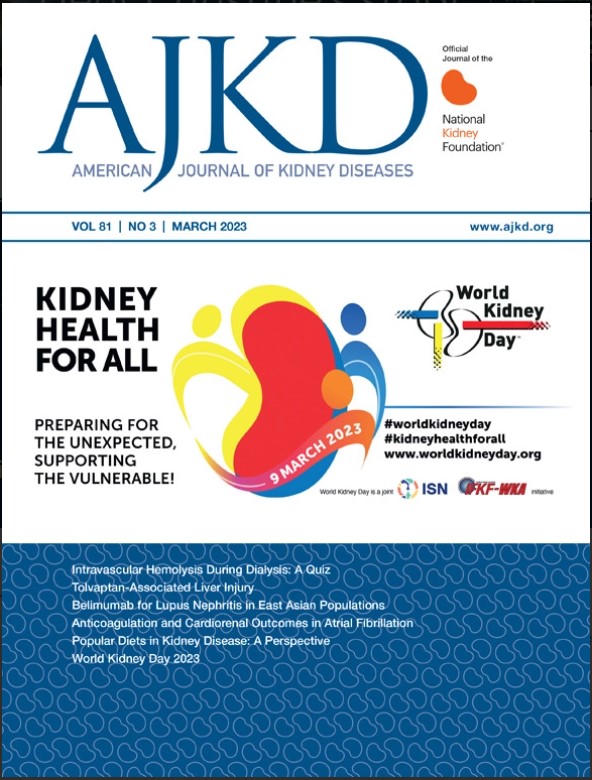Burden of CKD-Associated Pruritus and Adverse Clinical Outcomes in Patients Receiving Dialysis: The Stockholm Creatinine Measurements (SCREAM) Project
IF 8.2
1区 医学
Q1 UROLOGY & NEPHROLOGY
引用次数: 0
Abstract
Rationale & Objective
Pruritus is a common but not well-characterized complaint of patients receiving maintenance dialysis. This study sought to quantify the burden of pruritus and its associated adverse health outcomes in this population.
Study Design
Observational study.
Setting & Participants
All patients receiving maintenance dialysis in Stockholm, Sweden, during 2005-2021.
Exposure
Clinically recognized pruritus defined using International Classification of Diseases, Tenth Revision codes or a prescription for antipruritus treatments (including UV therapy).
Outcomes
All-cause mortality, severe infection–related hospitalizations (composite of endocarditis, peritoneal dialysis–related peritonitis, hemodialysis/peritoneal dialysis–related catheter infection, sepsis due to Staphylococcus spp., or skin infection) and incident diagnoses of anxiety/depression and sleep disorders.
Analytical Approach
Multivariable logistic regression and cause-specific hazards models to analyze factors associated with prevalent and new-onset pruritus, respectively. Multivariable cause-specific hazards models with time-varying exposure were used to explore the association of prevalent and new-onset pruritus with adverse health outcomes.
Results
Among 3,281 dialysis recipients (median age, 64 years; 66% men; 69% receiving hemodialysis, 77% with incident dialysis), 456 (14%) had pruritus at enrollment. During a median follow-up of 3.3 (IQR, 1.3-9.2) years, 539 (19%) additional patients experienced pruritus. Older age, female sex, a lower serum albumin level, and higher C-reactive protein, serum calcium, and phosphorus levels were independently associated with pruritus. Compared with patients without pruritus, patients with pruritus were at a higher risk of sleep disorders (adjusted HR, 1.96; 95% CI, 1.60-2.39), developing anxiety/depression (adjusted HR, 1.56; 95% CI, 1.23-1.98), and being hospitalized for severe infections (adjusted HR, 1.36; 95% CI, 1.18-1.57), the latter attributed to higher risk of sepsis and peritoneal dialysis–related peritonitis. There was no detectable association between the development of pruritus and all-cause mortality.
Limitations
Potential misclassification bias if pruritus is not clinically recognized, lack of information on pruritus intensity/severity, use of diagnostic codes for exposure and outcome diagnoses.
Conclusions
At least one third of patients experience pruritus during their first years undergoing dialysis, and pruritus was consistently associated with adverse health outcomes.
Plain-Language Summary
Pruritus is a common but not well-characterized symptom of patients receiving dialysis. We analyzed data from 3,281 patients receiving maintenance hemodialysis or peritoneal dialysis in the region of Stockholm, Sweden. At baseline, 14% of patients had pruritus, and pruritus developed in an additional 19% of patients during their time receiving dialysis. We identified conditions associated with the development of pruritus (eg, older age, female sex, lower serum albumin level, and higher C-reactive protein, serum calcium, and phosphorus levels) and observed that the presence of pruritus was associated with higher risks of sleep disorders, developing anxiety and depression, and being hospitalized for severe infections. No association between pruritus and all-cause mortality was identified.
透析患者中与 CKD 相关的瘙痒负担和不良临床结果:斯德哥尔摩 CREAtinine 测量(SCREAM)项目。
理由和目的:瘙痒症是接受维持性透析的患者的常见主诉,但没有得到很好的描述。本研究旨在量化透析患者瘙痒的负担及其相关的不良健康后果:观察性研究:环境和参与者:2005-2021年间在瑞典斯德哥尔摩接受维持性透析的所有患者:暴露:临床公认的瘙痒症,使用 ICD-10 编码或抗瘙痒治疗处方(包括紫外线疗法)定义:结果:全因死亡率、严重感染相关住院(心内膜炎、腹膜透析相关腹膜炎、血液透析/腹膜透析相关导管感染、葡萄球菌引起的败血症或皮肤感染的复合感染)以及焦虑/抑郁和睡眠障碍的事件诊断:分析方法:采用多变量逻辑回归和特定病因危险度模型分别分析与流行性瘙痒症和新发瘙痒症相关的因素。采用时变暴露的多变量特异性病因危险模型,探讨流行性瘙痒症和新发瘙痒症与不良健康后果之间的关联:在 3281 名透析患者(中位年龄为 64 岁,66% 为男性,69% 为血液透析患者,77% 为偶发性透析患者)中,456 人(14%)在入院时患有瘙痒症。在 3.3 [IQR: 1.3-9.2] 年的中位随访期间,又有 539 名(19%)患者出现了瘙痒症。年龄较大、性别为女性、血清白蛋白水平较低、C反应蛋白、血清钙和磷水平较高与瘙痒症有独立关联。与无瘙痒症的患者相比,有瘙痒症的患者患睡眠障碍(调整后 HR:1.96 [95%CI 1.60-2.39])、焦虑/抑郁(aHR:1.56 [1.23-1.98])和严重感染住院(aHR:1.36 [1.18-1.57])的风险更高,后者归因于败血症和腹膜透析相关腹膜炎的风险更高。罹患瘙痒症与全因死亡率之间没有可检测到的关联:局限性:如果瘙痒症未得到临床认可,则可能存在分类偏差;缺乏有关瘙痒症强度/严重程度的信息;使用诊断代码进行暴露诊断和结果诊断:结论:至少有三分之一的患者在透析的最初几年中经历过瘙痒症,瘙痒症与不良健康后果始终相关。
本文章由计算机程序翻译,如有差异,请以英文原文为准。
求助全文
约1分钟内获得全文
求助全文
来源期刊

American Journal of Kidney Diseases
医学-泌尿学与肾脏学
CiteScore
20.40
自引率
2.30%
发文量
732
审稿时长
3-8 weeks
期刊介绍:
The American Journal of Kidney Diseases (AJKD), the National Kidney Foundation's official journal, is globally recognized for its leadership in clinical nephrology content. Monthly, AJKD publishes original investigations on kidney diseases, hypertension, dialysis therapies, and kidney transplantation. Rigorous peer-review, statistical scrutiny, and a structured format characterize the publication process. Each issue includes case reports unveiling new diseases and potential therapeutic strategies.
 求助内容:
求助内容: 应助结果提醒方式:
应助结果提醒方式:


